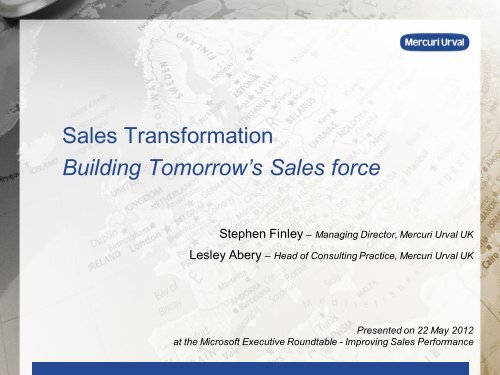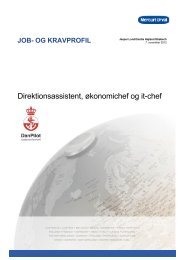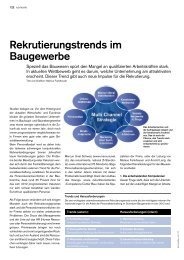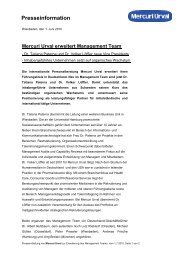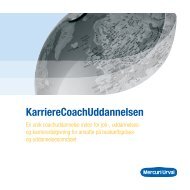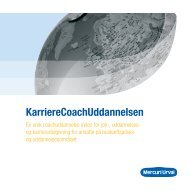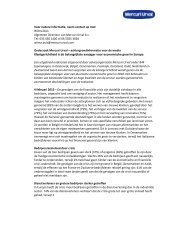Sales Transformation Presentation - Mercuri Urval
Sales Transformation Presentation - Mercuri Urval
Sales Transformation Presentation - Mercuri Urval
Create successful ePaper yourself
Turn your PDF publications into a flip-book with our unique Google optimized e-Paper software.
<strong>Sales</strong> <strong>Transformation</strong><br />
Building Tomorrow’s <strong>Sales</strong> force<br />
Stephen Finley – Managing Director, <strong>Mercuri</strong> <strong>Urval</strong> UK<br />
Lesley Abery – Head of Consulting Practice, <strong>Mercuri</strong> <strong>Urval</strong> UK<br />
Presented on 22 May 2012<br />
at the Microsoft Executive Roundtable - Improving <strong>Sales</strong> Performance
Transforming your sales operation is a fast and<br />
efficient way of improving profits and growing income<br />
.<br />
To get it right, we believe sales force transformation<br />
should be embedded in the company as a permanent,<br />
forward-moving, capability-building activity informed<br />
by future customer needs and led from the front.
A client driven transformation process process
An overall <strong>Sales</strong> <strong>Transformation</strong> Process
What we’ve heard clients say<br />
‘Contact is good but it is largely demand driven…we should<br />
get together and anticipate the future’<br />
‘Nobody ever contacts me from ABC Ltd to get together on<br />
my real business issues’<br />
‘You always respond quickly when we have a problem but<br />
you never call us with a fresh idea’<br />
‘My biggest customer? What is their future strategy? Good<br />
question… I’ve got it here somewhere …’
Goal. Take a look at your business model<br />
with fresh eyes<br />
• How do you make money? What is the value you create?<br />
• Define your business model in terms of creating value for your<br />
customer<br />
• Understand your market position relative to your competitors – now<br />
and in the future<br />
• Look at where you fit in your customers’ value chain<br />
• Get an objective view from your customers as to their perception of<br />
your business<br />
• Look at your leaders. Do they represent your customers needs or those<br />
of your internal management?
Who. Define which clients to focus on,<br />
why and with what proposition<br />
• Which clients have the most potential ?<br />
• How will you change to achieve future results?<br />
• What activities do you need to implement to close the gap?<br />
• Build a clear picture of your business - analyse input from<br />
stakeholders and customers, and examine competitors’ behaviour<br />
• Describe the journey between today and the future, in a way that<br />
is clear and compelling for employees, customers and<br />
stakeholders<br />
Success in business depends on understanding where value is really<br />
created and putting that at the centre of your business strategy
How. Define your customer engagement<br />
model<br />
• How does your company build relationships with customers, and<br />
who builds these relationships?<br />
• Understand how you connect and engage with customers today to<br />
help you establish a closer relationship with them in the future<br />
• Enable your employees to establish a wide network of relationships<br />
with client contacts<br />
• Position people in deeper, stronger and broader networks - this will<br />
make your relationship less vulnerable to risk and change
Define your customer engagement model<br />
Typical Key Account Client Engagement<br />
Model
What. Define and build the right skills to<br />
engage with your clients<br />
• What is your organisational structure? How do you work?<br />
• What processes are being used, and what processes do you need to<br />
make things flow even better?<br />
• Where are efficiencies, contact points, handoffs and bottlenecks?<br />
• What skills and future potential do your people have given the skills<br />
required in future ?<br />
• Define the future skills needed, assess your current skills and<br />
measure the gap between where you need to be and where you<br />
stand today
Define Organisational Structure<br />
Key Positions<br />
Key People<br />
Strong Areas<br />
Weak Areas
Manage Resistance. People create … and<br />
resist change<br />
Knowledge & Experience<br />
Saboteurs<br />
Dinosaurs<br />
Change<br />
Leaders<br />
Dangerous<br />
Amateurs<br />
Motivated to Change
Assess your capability gaps<br />
<strong>Sales</strong> Manager<br />
Account Executive<br />
<strong>Sales</strong> Specialist<br />
Solution<br />
Development<br />
<strong>Sales</strong> Support<br />
Create Compelling<br />
Propositions<br />
Builds Valuable<br />
Relations<br />
Wins Profitable<br />
Business<br />
Mobilise to Deliver<br />
Coaching for<br />
Performance<br />
Today 18 mths Today 18 mths Today 18 mths Today 18 mths Today 18 mths<br />
6 7 5 6 7<br />
6 6 6 6 4<br />
5 5 5 6 4<br />
6 5 4 6 6<br />
2 5 4 5 4
Assess your capability gaps<br />
<strong>Sales</strong> Manager<br />
Account Executive<br />
<strong>Sales</strong> Specialist<br />
Create compelling<br />
propositions<br />
Builds Valuable<br />
Relations<br />
Wins profitable<br />
Business<br />
Mobile to Deliver<br />
Coaching for<br />
Performance<br />
Today 18 mths Today 18 mths Today 18 mths Today 18 mths Today 18 mths<br />
2 1 2 1 1 1 2 1 3 2<br />
6 7 5 6 7<br />
3 2 2 1 2 1 3 2 2 1<br />
6 6 6 6 4<br />
2 1 1 1 2 1 3 2 2 1<br />
5 5 5 6 4<br />
Solution<br />
Development 3 2 2 1 1 1 3 2 3 3<br />
<strong>Sales</strong> Support<br />
6 5 4 6 6<br />
1 1 2 1 3 2 2 1 2 1<br />
2 5 4 5 4
Decide on who and where<br />
• Who is going to be developed and/or promoted?<br />
• Who ought to be redeployed?<br />
• Who needs to be exited?<br />
• If your future model is aspirational and transformative - one third of<br />
your people may not be able to deliver in the new world<br />
How you lead and guide them to find their future is a key mark of<br />
success
Routinely audit client and sales team performance<br />
CLIENT<br />
Account<br />
Status<br />
CPG<br />
CP CDD CSE SM<br />
ABC AMBER NA n n NA<br />
HEI GREEN n n n n<br />
SRAM AMBER n n n NA<br />
NES GREEN n n n n<br />
COSI AMBER NA n n NA<br />
ELBA AMBER NA n n<br />
REL RED NA n NA NA<br />
REV AMBER NA n n n<br />
CLIENT<br />
Account<br />
Status<br />
UK<br />
CP CDD CSE SM<br />
RM GREEN n NA NA NA<br />
INI AMBER n n n NA<br />
DRA AMBERn NA NA NA NA<br />
KEY<br />
GOLD RATING<br />
n SILVER RATING<br />
n<br />
BRONZE RATING<br />
NA NO RATING ISSUED<br />
nnn ACCOUNT RATINGS
The <strong>Sales</strong> Force <strong>Transformation</strong> Guide –<br />
what successful growth leaders know:<br />
• <strong>Sales</strong> force transformation should be embedded in the company as a<br />
permanent, forward-moving, capability-building solution<br />
• Understand where your value is really created, and put that at the<br />
centre of your business and sales strategy<br />
• Understand – in detail – how you engage with customers, and enable<br />
your employees to establish a wide network of client relationships<br />
• Be clear about how each of your company’s departments interact to<br />
create the value you are aiming for<br />
• Don’t water down the execution of your assessment findings<br />
• Remember that tomorrow’s successful companies will restructure<br />
capabilities, not job titles
A client driven transformation process process
.<br />
To find out more about <strong>Sales</strong> <strong>Transformation</strong> please<br />
contact<br />
Stephen Finley – stephen.finley@mercuriurval.com<br />
Lesley Abery – lesley.abery@mercuriurval.com<br />
or visit<br />
www.mercuriurval.co.uk


